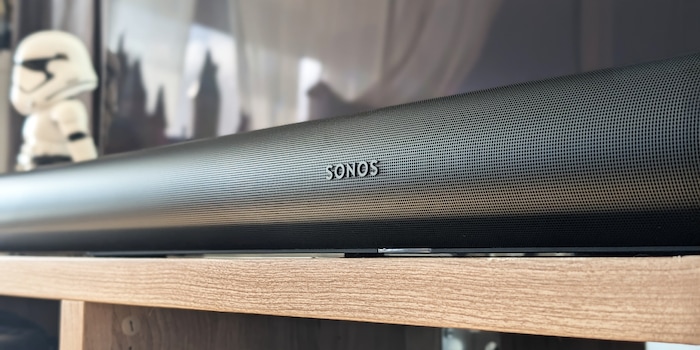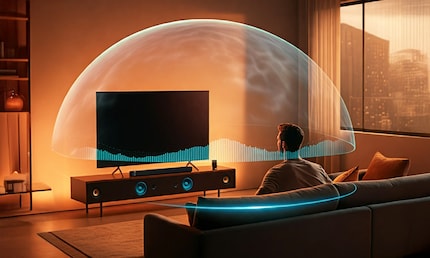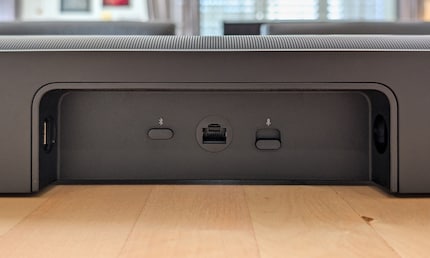
News + Trends
Sonos Arc Ultra and Sub 4: New standards for soundbars and subwoofers?
by Luca Fontana

Four years after the Sonos Arc comes the new generation: the Sonos Arc Ultra. With its innovative Sound Motion technology and 14 drivers, it promises an even more intense sound experience. Can the new soundbar fulfil the high expectations?
It was about time that Sonos gave the top of its soundbar portfolio an update. After all, the Sonos Arc, the "old" flagship, is already more than four years old. Back then, Dolby Atmos - sound from above - was presented as a major innovation. And today?
Today, the Sonos Arc Ultra, the new flagship, wants to be seen as a soundbar that has been rethought from the ground up. The Arc Ultra has a new centrepiece: "Sound Motion" technology, as Paul Peace, Sonos Head of Audio Platform Development, tells a number of other journalists and me on the call. This is a sound conversion technology that should make it possible to produce an "even greater fullness of sound" despite more compact speakers.
The technology, we were told on request, comes from Mayht, a start-up that Sonos acquired in 2022. And Sonos still has big plans for Mayht's expertise, says Paul Peace. In fact, despite its slightly narrower housing, the Arc Ultra already houses 14 drivers - three more than its predecessor.
Time to listen to the new soundbar messiah.
The Sonos Arc Ultra has become slightly wider. Just under 118 centimetres wide. Compared to its predecessor, the Arc, that's about three centimetres more. Quite bulky, especially for those who have a rather small TV - the Arc Ultra will tower over a TV screen diagonal of up to 49 inches. For small TVs in (possibly) smaller living rooms, however, the Arc Ultra would be overkill anyway. I would personally go for a Sonos Beam there.
On the other hand, the Arc Ultra is around one centimetre less high and one centimetre less deep than its predecessor. Sounds like little. But it makes a big difference in height: If the soundbar blocks the TV's infrared sensor, switching it on and off using the remote control will cause your wrist to cramp. So to summarise:
Width: 117.8 cm
Height: 7.5 cm
Depth: 11.06 cm
But bulky doesn't mean clunky - or even ugly. On the contrary. At first glance, the Arc Ultra and its predecessor are almost indistinguishable: Similar grille, plus an oval, less angular shape and all in matt black or white. I think it's classy.
Underneath the grille are a total of 14 drivers, which together provide a 9.1.4 sound system. There are also 15 class D digital amplifiers. In concrete terms, there are:
If that's all a bit too much jargon for you, just know that Sonos promises you an incredibly wide and high soundstage that tricks you into thinking there are a lot more speakers in the room than just a single soundbar - even above you.
I would like to open an important parenthesis here: Soundbar manufacturers are constantly talking about great, room-filling sound thanks to sophisticated 3D sound effects that do not require additional speakers in the room. However, this requires the sound to be digitally manipulated. In other words, complicated calculations and algorithms are used to ensure that you hear a sound behind you even though there are no speakers - the only sound source is the soundbar in front of you.
Mathematics for your ears, so to speak.
But - and I'll close the parenthesis again: No matter how many algorithms and technologies try to fool you and your ears - as long as there aren't speakers everywhere in the room like in the cinema, the promise of real 3D sound from all manufacturers remains pure marketing. So don't expect that when a helicopter flies through the picture, you will actually hear the helicopter above your head if you don't have ceiling speakers.
For the test, I calibrated the Arc Ultra via the Sonos app. Calibration is automatic with the Sonos app's Trueplay function: while I shuffle around the room fidgeting with my mobile, the Arc Ultra emits sonar-like signals. I imagine how it is creating a "bell" customised to the floor plan and room height, which will later be placed over me. So that my ears later perceive loudspeakers where there are none.

To help you understand what I mean, here's a video of what the Sonos Beam looked like three years ago (the principle is exactly the same):
Apropos Trueplay: This is now also available in a slightly slimmed-down version for Android phones; previously this was only available to Apple users. That's great, at least Android phones can now also calibrate properly. But Apple's version, which takes a little longer to calibrate, is more accurate.
Well then. To hear how the Sonos Arc Ultra sounds, I first listen to my usual film and music samples with an additional subwoofer set up (Sonos Sub 4) and surround speakers (Sonos Era 300) - the total "home cinema experience", so to speak. Only then do I remove the subwoofer and surround speakers to hear how much "worse" the same examples sound and what exactly is "lost" compared to the complete surround sound.
I'll start with the best racing scene from "Ford vs Ferrari" - the one that takes place at night during the 24 Hours of Les Mans. The film is one of my absolute favourite films anyway. That's why I know pretty much exactly how the sound should sound.
Source: UHD-Blu-Ray, Sound: English, Dolby Atmos
With subwoofer and surround speaker: It's raining. The visibility is terrible. But even through the deafening concert of howling engines, screeching tyres, crunching car bodies and the pattering of the heavy rain, Miles' voice comes through clearly. "Bloody hell!" he curses in his unmistakable British accent, while the cars creak and groan under the enormous centrifugal forces.
That's what Atmos is all about.
Sonos Arc Ultra alone: Firstly, I close my eyes. I want to concentrate on the sound, not the picture. Then I open them again in surprise. "Wait a minute, haven't I decoupled the subwoofer?" I ask myself as I check the Sonos app again. Yes, I have. Unbelievable: the Arc Ultra hums softly yet powerfully when roughneck Miles presses down on the accelerator and lets the 550 hp of his Ford GT's V8 engine roar. There's no scratching and no rollover. A balance that I would never have expected from a soundbar if I hadn't heard it myself.
So, the Sound Motion technology is not pure Marketing-speak. It fulfils the promise of delivering bass that sounds like it's coming from a large, voluminous subwoofer, despite the incredibly compact dual cone woofers.
Next example: The film starring Chris Pratt is about a war that is fought and lost in the future. People therefore travel to the past - our present - to get reinforcements in the form of cannon fodder. This is exactly where my test scene begins, which is particularly challenging for sound systems because sound also has to come from above - vertical sound.
Source: Amazon Prime Video. sound: English, Dolby Atmos
With subwoofer and surround speaker: Surrounded by billowing energy and glistening lightning, a gateway to the future opens with a thunderous bang on the ceiling of the hall: a wormhole that pulls Chris Pratt and his soldiers up into its maw. Then the sheer horror: Pratt, I and dozens of other time travellers suddenly find ourselves hundreds of metres above the ground, in the middle of a cloud - and we crash. The wind hisses from everywhere. The screams echo from the front speakers. Then from the rear ones.
One thing is certain: the soundstage is wide, powerful and captivating - but not as vertical as I remember Sony's HTA9 system, for example. Especially when the soldiers are pulled up into the future, I would have liked more verticality in the sound. Instead, it remains broad and voluminous, but always at roughly the same level as me.
Sonos Arc Ultra alone: Something interesting is happening here: If my ears aren't deceiving me, the sound now actually sounds more vertical than before. Why is that? Maybe the surround speakers to my left and right drowned out the vertical soundtracks of the Arc Ultra. Or maybe I just have funny ears. What speaks in favour of the former is that the sound stage without surround speakers actually seems less wide than before. But that was to be expected.
What remains phenomenal is the bass: Pratt looks down. Roofs are rapidly approaching; they must be skyscrapers. The first hapless people crash onto hard stone. Bones break. Bodies are crushed. The bass rumbles. It's still thundering around me. Then I see how some miss the roofs, fall further and further. Their screams become quieter. The hairs on the back of my neck stand up.
I need a break.
In typical Sonos fashion, the Arc Ultra can also be used as a multi-room speaker - and the surround sound system, including the two Era 300s and the Sub 4, can be used at the same time. For the test, however, I will leave the set-up with the Arc Ultra alone.
How does that sound? Really good. John Powell's "This is Berk" from "How to train your Dragon" shows me. I already used his music in my Sonos Arc test. After all, its score has everything it needs for a good test: calm, leisurely passages, beautifully complex architectures and loud, triumphant music.
So I know exactly where the bass needs to hum - and where I want to feel the "punch".
The score begins with brass instruments grumbling slowly. They play the topic of Berk, the film's Viking village. The trombones already sounded strong and voluminous in the Arc. They still do on Arc Ultra, of course. Then the strings kick in. I even think I can hear a clarinet somewhere, elegantly standing out from the drums in the background as they gently and quietly set the pace.
Minute 1:10. The action passages. A complex, difficult transition. Strong and full. Challenging for many soundbars. Because the percussion builds to a crescendo. A male choir with deep, rumbling voices is wild and untamed. The bass easily keeps up without scratching once. While the imaginary camera flies over the village of the crazy Vikings, soon to be riding dragons, in the film, the soundbar fills my living room even without
surround speakers or an additional subwoofer.
Next song. This time "Another Day of Sun" from the film "La La Land". The song is not only jazz in perfection, but also offers a wide sound stage with many instruments and vocals. This puts every soundbar to the test, especially in terms of clarity, dynamics and spatiality.
I fall in love with the song in less than two seconds - once again. The pianist hits the keys, ensnaring my ears with playful harmonies. Then, after eight seconds, the first "Hmpf" punch: the nylon brushes in the high frequencies caress the drums. The singer's voice stands out from the musical meshwork, filling the middle channels with warm, deep mids and wonderful clarity. Finally, the double bass kicks in, humming cosily from now on, while the drums playfully provide the rhythmic drive in the background.
There it is again, this sound motion technology.
One small point of criticism: the connections. The Arc Ultra still only offers a single HDMI eARC input. This is a little meagre for a soundbar in this price range. At least one additional HDMI 2.1 connection would have been desirable. In contrast to its predecessor, not even an HDMI-to-Toslink adapter is included this time if your TV doesn't have an ARC or eARC connection.
This does make a difference in terms of sound. Although the optical Toslink interface offers sufficient bandwidth for surround sound such as Dolby Digital 5.1, it is not sufficient for high-resolution audio formats such as Dolby Atmos or DTS:X. So if you play Dolby Atmos, you will only receive Dolby Digital 5.1 on the soundbar in this case.

Also important: Sonos and DTS still have their difficulties with each other - licence problems. Although the situation has improved compared to the past, Sonos is still unable to play modern DTS formats such as DTS:X or DTS Master HD in 3D or High-Res. At least Sonos has supported DTS Digital Surround 5.1 for some time now, which is at least better than the previous conversion of all DTS sources to simple stereo.
In my test with the Sonos Arc Ultra and a Samsung TV, which I am currently testing, all DTS Master HD soundtracks were reproduced as Dolby multichannel PCM 5.1 signals, not as DTS Digital Surround 5.1 signals. I can't say for sure whether this is due to the TV or Sony UHD Blu-ray player not transmitting DTS correctly to the soundbar, or to the Arc Ultra itself. However, I seem to remember that my LG TV delivered a DTS Digital Surround 5.1 signal to the Sonos soundbar in such cases.
Yep, audio can be a real clusterfuck sometimes.
The Sonos Arc Ultra once again impressively demonstrates that soundbars are no longer just practical additions to TV systems, but can now convey a real home cinema feeling. With its revised hardware, led by the innovative Sound Motion technology, it clearly stands out from its predecessor, especially in terms of bass: I've never heard a soundbar hum so voluminously and powerfully. But even with complex soundscapes - be it orchestral film music, dynamic action scenes or subtle dialogue - the Arc Ultra impresses with its impressive precision and spatial depth.
The 14 drivers and the 9.1.4-channel setup deliver a sound image that fills the room thanks to Dolby Atmos and careful Trueplay calibration. It is particularly remarkable how well the Arc Ultra performs even without additional speakers. It creates a wide, clear sound stage that reproduces even demanding scenes with highs and lows cleanly.
There are small compromises in the connections. The lack of additional HDMI ports and the still limited DTS compatibility reduce the universal use somewhat. But if you have enough space and budget for this premium device, you will be rewarded with a sound miracle that will delight audiophile music lovers and film fans alike.
Pro
Contra
I write about technology as if it were cinema, and about films as if they were real life. Between bits and blockbusters, I’m after stories that move people, not just generate clicks. And yes – sometimes I listen to film scores louder than I probably should.